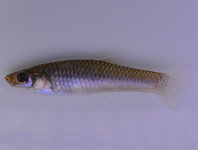Abstract
The range of hearing for human is about 50 to 20,000 Hz, but some animals can produce ultrasounds over 20000 Hz. These include bats, cetaceans, rodents and even frogs (Feng et al., 2006). Katydids and crickets are famous singing insects belonging to order Orthoptera. Many katydids can produce ultrasounds even over 100 kHz (Montealegre-Z et al., 2006). However, the dominant frequency of most crickets ranges from 2 to 8 kHz (Walker & Carlysle, 1975; Robillard & Desutter-Grandcolas, 2004). In previous studies, only Eneopterinae crickets were reported to produce high-frequency songs (Robillard et al. 2007; Robillard & Tan 2013). We report that Lissotrachelus ferrugineonotatus crickets produce ultrasounds with peak at 26.25 kHz.
References
Brunner von Wattenwyl, C. (1893) Revision du systeme des Orthopteres et description des especes rapportees par M. Leonardo Fea de Birmanie. Annali del Museo civico di Storia naturale di Genova, 2 (13), 1–230.
https://doi.org/10.5962/bhl.title.5121
Chopard, L. (1969) Grylloidea. The fauna of India and adjacent countries. Orthoptera. Vol. 2. Baptist Mission Press, Calcutta, 421 pp.
Feng, A.S., Narins, P.M., Xu, C.-H., Lin, W.-Y., Yu, Z.-L., Qiu, Q., Xu, Z.-M. & Shen, J.-X. (2006) Ultrasonic communication in frogs. Nature, 440, 333–336.
https://doi.org/10.1038/nature04416
Kirby, W.F. (1906) Orthoptera Saltatoria. Part I. (Achetidae et Phasgonuridae). A Synonymic Catalogue of Orthoptera (Orthoptera Saltatoria, Locustidae vel Acridiidae), 2, i–viii + 1–562
Montealegre-Z, F., Morris, G.K. & Mason, A.C. (2006) Generation of extreme ultrasonics in rainforest katydids. The Journal of Experimental Biology, 209, 4923–4937.
https://doi.org/10.1242/jeb.02608
Robillard, T. & Desutter-Grandcolas, L. (2004) High-frequency calling in Eneopterinae crickets (Orthoptera, Grylloidea, Eneopteridae): adaptive radiation revealed by phylogenetic analysis. Biological Journal of the Linnean Society, 83, 577–584.
https://doi.org/10.1111/j.1095-8312.2004.00417.x
Robillard, T. & Tan, M.K. (2013) A taxonomic review of common but little known crickets from Singapore and the Philippines (Insecta: Orthoptera: Eneopterinae). The Raffles Bulletin of Zoology, 61 (2), 705–725.
Robillard, T., Grandcolas, P. & Desutter-Grandcolas, L. (2007) A shift toward harmonics for high-frequency calling shown with phylogenetic study of frequency spectra in Eneopterinae crickets (Orthoptera, Grylloidea, Eneopteridae). Canadian Journal of Zoology, 85 (12), 1264–1274.
https://doi.org/10.1139/Z07-106
Walker, T.J. & Carlysle, T.C. (1975) Stridulatory file teeth in crickets: taxonomic and acoustic implications (Orthoptera: Gryllidae). International Journal of Insect Morphology and Embryology, 4 (2), 151–158.
https://doi.org/10.1016/0020-7322(75)90013-6
Yin H.-S. & Liu X.-W. (1995) Synopsis on the classification of Grylloidea and Gryllotalpoidea from China. Shanghai Scientific and Technological Literature, Shanghai, 237 pp.


